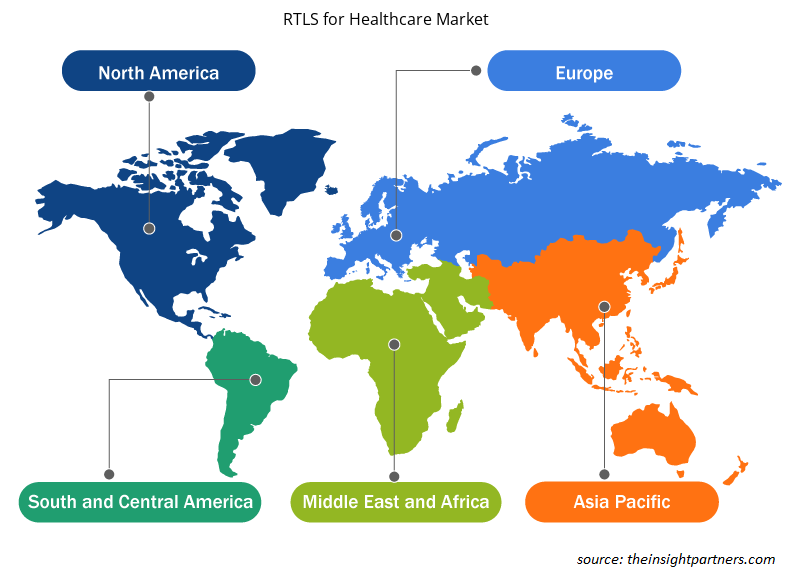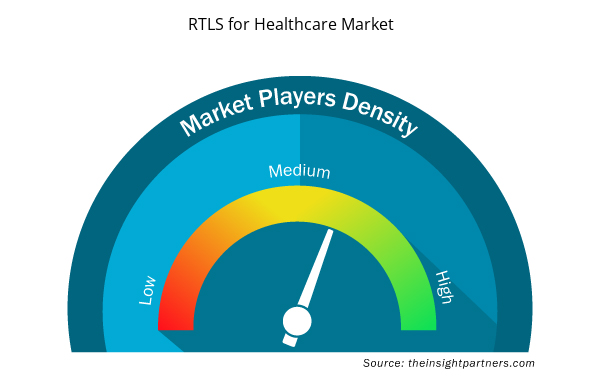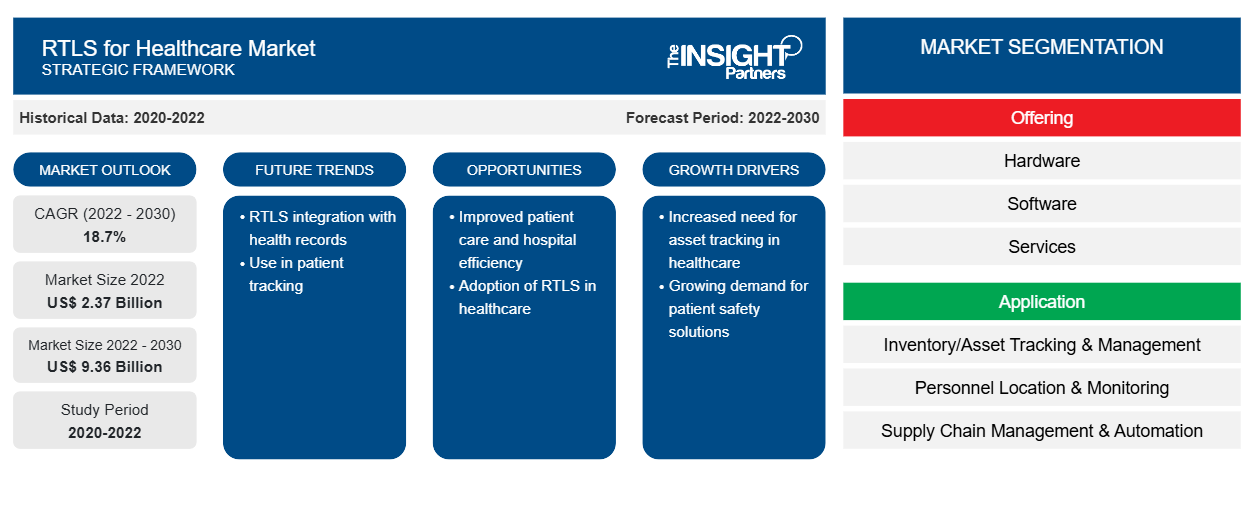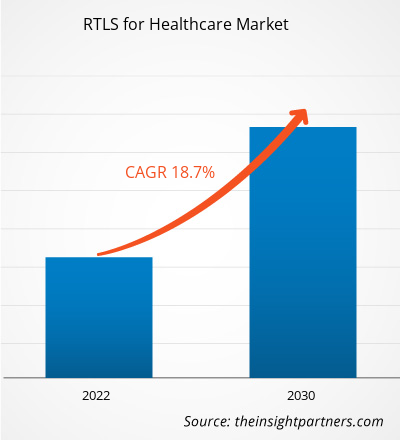[Forschungsbericht] Der RTLS-Markt für das Gesundheitswesen wurde im Jahr 2022 auf 2,37 Milliarden US-Dollar geschätzt und soll bis 2030 9,36 Milliarden US-Dollar erreichen. Für den Zeitraum 2022–2030 wird eine durchschnittliche jährliche Wachstumsrate (CAGR) von 18,7 % erwartet.
Markteinblicke und Analystenansichten:
Echtzeit-Standortdienste (RTLS) im Gesundheitswesen werden verwendet, um in allen Arten von Gesundheitseinrichtungen eine Echtzeitverfolgung sowie die Verwaltung von Personal, medizinischer Ausrüstung und Patienten zu ermöglichen. Gesundheitseinrichtungen wie Krankenhäuser, Seniorenwohnheime, ambulante Zentren und Diagnoselabore verwenden RTLS, um medizinische Ausrüstung, Patienten, medizinisches Personal und Berichte zu verfolgen. Seniorenwohnheime verwenden beispielsweise über RTLS verbundene Tags und Abzeichen, um die geriatrische Bevölkerung zu verfolgen, die hauptsächlich an Alzheimer oder Gedächtnisverlust leidet. Das zunehmende Bewusstsein für die Vorteile von RTLS für die Personalverwaltung und die hohe Kapitalrendite bei reduziertem Kapitalaufwand treibt die Größe des RTLS-Marktes für das Gesundheitswesen voran .
Wachstumstreiber und Herausforderungen:
Der Mangel an medizinischem Fachpersonal und die zunehmende Nutzung von RTLS gehören zu den Faktoren, die das Wachstum von RTLS für den Gesundheitsmarkt vorantreiben. Weltweit herrscht ein erheblicher Mangel an medizinischem Fachpersonal. Im Jahr 2020 stellte der erste Bericht der Weltgesundheitsorganisation (WHO) über den Zustand der Krankenpflege (SOWN) fest, dass es weltweit 27,9 Millionen Pflegekräfte gibt, und prognostizierte bis 2030 einen weltweiten Mangel von 5,9 Millionen Pflegekräften. Laut den Daten der Association of American Medical Colleges (AAMC) wird in den USA bis 2030 ein Mangel von etwa 120.000 Ärzten erwartet, was sich auf die allgemeine Patientenversorgung im ganzen Land auswirken wird. In einem von Siemens veröffentlichten Artikel verbringen Pflegekräfte etwa 72 Minuten pro Schicht mit der Suche nach Geräten, und die durchschnittliche Geräteauslastungsrate liegt bei unter 40 %, während der Anteil verlorener oder gestohlener Vermögenswerte in Einrichtungen ohne Echtzeit-Ortungsdienste (RTLS) auf etwa 10 % geschätzt wird. Angesichts des Personalmangels wird die Suche nach Ausrüstung für die Krankenschwestern zu einer unnötigen Aufgabe. Um die Zeit des verfügbaren Personals besser zu verwalten, konzentrieren sich Gesundheitseinrichtungen daher auf die Installation von RTLS-Systemen, mit denen sie die benötigte Ausrüstung oder das benötigte Personal leicht finden können. Aufgrund des Mangels an medizinischem Fachpersonal haben Gesundheitseinrichtungen begonnen, RTLS-Technologie zu verwenden, um den Arbeitsablauf in ihren Einrichtungen zu verwalten.
Der Einsatz der RTLS-Technologie für eine ordnungsgemäße Konnektivität bei der häuslichen Gesundheitspflege dürfte in den kommenden Jahren neue Trends im Bereich RTLS für das Gesundheitswesen mit sich bringen.
Passen Sie diesen Bericht Ihren Anforderungen an
Sie erhalten kostenlos individuelle Anpassungen an jedem Bericht, einschließlich Teilen dieses Berichts oder einer Analyse auf Länderebene, eines Excel-Datenpakets sowie tolle Angebote und Rabatte für Start-ups und Universitäten.
- Holen Sie sich die wichtigsten Markttrends aus diesem Bericht.Dieses KOSTENLOSE Beispiel umfasst eine Datenanalyse von Markttrends bis hin zu Schätzungen und Prognosen.
Berichtssegmentierung und -umfang:
Die Marktanalyse für RTLS im Gesundheitswesen wurde unter Berücksichtigung der folgenden Segmente durchgeführt: Angebot, Technologie, Anwendung, Einrichtungstyp und Geografie. Nach Angebot ist der Markt in Hardware, Software und Dienstleistungen unterteilt. Das Hardwaresegment ist weiter unterteilt in Lesegeräte/Tracker/Zugangspunkte, Tags/Ausweise und andere Hardware. Das Dienstleistungssegment ist weiter unterteilt in Beratung, Bereitstellung und Integration sowie Support und Wartung. Basierend auf der Anwendung ist der Markt unterteilt in Inventar-/Vermögensverfolgung und -verwaltung, Personalortung und -überwachung, Lieferkettenmanagement und -automatisierung und andere.
In Bezug auf die Technologie ist der Markt in Wi-Fi, RFID und andere segmentiert. Nach Einrichtungstyp ist der Markt in Krankenhäuser und Gesundheitseinrichtungen sowie Seniorenwohnheime segmentiert. Geografisch ist der RTLS-Markt für das Gesundheitswesen hauptsächlich in Nordamerika (USA, Kanada und Mexiko), Europa (Spanien, Großbritannien, Deutschland, Frankreich, Italien und der Rest von Europa), Asien-Pazifik (Südkorea, China, Indien, Japan, Australien und der Rest von Asien-Pazifik), Naher Osten und Afrika (Südafrika, Saudi-Arabien, die Vereinigten Arabischen Emirate und der Rest von Nahem Osten und Afrika) und Süd- und Mittelamerika (Brasilien, Argentinien und der Rest von Süd- und Mittelamerika) unterteilt.
Segmentanalyse:
Der RTLS-Markt für das Gesundheitswesen ist nach Angebot in Hardware sowie Software & Services unterteilt. Hardware ist weiter in Lesegeräte/Tracker/Zugangspunkte, Tags/Badges und andere Hardware unterteilt. Im Jahr 2022 hatte das Segment Software & Services den größten Marktanteil und wird voraussichtlich zwischen 2022 und 2030 die höchste durchschnittliche jährliche Wachstumsrate verzeichnen. Das Wachstum im Segment Software & Services wird durch die Einführung von Softwareprodukten von Unternehmen zur Verbesserung der Effizienz von RTLS-Systemen vorangetrieben . So brachte Midmark RTLS im Juni 2021 eine cloudbasierte Bluetooth Low Energy (BLE)-Asset-Tracking-Lösung auf den Markt, die die Asset-Tracking-Funktionen modernisiert.
Basierend auf der Anwendung ist der Markt in Inventar-/Vermögensverfolgung und -verwaltung, Personalortung und -überwachung, Lieferkettenmanagement und -automatisierung und andere unterteilt. Im Jahr 2022 hatte das Segment Inventar-/Vermögensverfolgung und -verwaltung den größten Marktanteil bei RTLS für das Gesundheitswesen. Das Segment Personalortung und -überwachung wird voraussichtlich zwischen 2022 und 2030 die höchste durchschnittliche jährliche Wachstumsrate verzeichnen.
Basierend auf der Technologie ist der RTLS-Markt für das Gesundheitswesen in Wi-Fi, Radiofrequenz-Identifikation (RFID) und andere segmentiert. Im Jahr 2022 hielt das RFID-Segment den größten Marktanteil und wird voraussichtlich zwischen 2022 und 2030 die höchste durchschnittliche jährliche Wachstumsrate verzeichnen.
Der Markt ist nach Einrichtungstyp in Krankenhäuser und Gesundheitseinrichtungen sowie Seniorenwohnheime segmentiert. Im Jahr 2022 hatte das Segment Krankenhäuser und Kliniken einen größeren RTLS-Marktanteil im Gesundheitswesen und wird voraussichtlich zwischen 2022 und 2030 eine höhere CAGR verzeichnen.
Regionale Analyse:
Der Umfang des RTLS-Marktberichts für das Gesundheitswesen konzentriert sich auf Nordamerika, Europa, den asiatisch-pazifischen Raum, den Nahen Osten und Afrika sowie Süd- und Mittelamerika. Der asiatisch-pazifische Raum wird voraussichtlich zwischen 2022 und 2030 die höchste CAGR auf dem Markt aufweisen. Nordamerika hatte 2022 den größten Anteil am Weltmarkt aufgrund der zunehmenden Zahl technologisch fortschrittlicher Krankenhäuser, des zunehmenden Einsatzes von RTLS in Seniorenwohnheimen und der häuslichen Pflege sowie der Präsenz wichtiger Marktteilnehmer, die an neuen und bestehenden Produktentwicklungen beteiligt sind. Nordamerika trägt am meisten zum Wachstum des RTLS-Marktes für das Gesundheitswesen bei. In Nordamerika hatten die USA 2022 den größten Marktanteil.
Branchenentwicklungen und zukünftige Chancen:
Die Marktprognose für RTLS für das Gesundheitswesen basiert auf verschiedenen sekundären und primären Forschungsergebnissen wie wichtigen Unternehmenspublikationen, Verbandsdaten und Datenbanken. Nachfolgend sind einige Pläne der wichtigsten Akteure auf dem RTLS-Markt für das Gesundheitswesen aufgeführt:
- Im April 2022 brachte Cognosos eine neue Softwaresuite für medizinische Geräte mit dem Namen Proactive Periodic Automated Replenishment (ProPAR) auf den Markt. ProPAR ist eine digitale Version von RTLS-Dashboards und -Lösungen, die zentrale Versorgungs- und Medizintechnikteams unterstützen, indem sie sofortige Transparenz über die Anzahl der Anlagen und die PAR-Schwellenwerte in Gesundheitseinrichtungen bieten. ProPAR nutzt die Indoor-RTLS-Lokalisierungslösung LocationAI von Cognosos, die eine raumgenaue Sichtbarkeit des Gerätestandorts bietet, sodass die Suche nach Geräten zur Reinigung, Umwälzung und Wartung entfällt und sichergestellt wird, dass die PAR-Werte konstant eingehalten werden.
- Im Juli 2020 brachte Advantech sein RTLS Solution-Ready Package (SRP) auf den Markt, das für die Echtzeitortung und -überwachung von medizinischer Ausrüstung, Personal und Patienten entwickelt wurde. Das RTLS SRP von Advantech ist eine Hardware-Software-Lösung, die Standortsensoren, Edge-Server, Tags, Tablets für medizinische Zwecke, Dashboards und RTLS-Verwaltungssoftware umfasst. Die Integration der Multi-Mode Sensing Dynamic Fusion (MSDF)-Technologie von Advantech mit RTLS SRP reduziert Störungen durch Hindernisse und verbessert die Ortungsleistung in komplexen Innenumgebungen.
Regionale Einblicke in den RTLS-Markt im Gesundheitswesen
Die regionalen Trends und Faktoren, die den RTLS-Markt für das Gesundheitswesen während des gesamten Prognosezeitraums beeinflussen, wurden von den Analysten von Insight Partners ausführlich erläutert. In diesem Abschnitt werden auch RTLS-Marktsegmente und die Geografie in Nordamerika, Europa, im asiatisch-pazifischen Raum, im Nahen Osten und Afrika sowie in Süd- und Mittelamerika erörtert.

- Erhalten Sie regionale Daten zum RTLS-Markt im Gesundheitswesen
Umfang des Marktberichts zu RTLS für das Gesundheitswesen
| Berichtsattribut | Details |
|---|---|
| Marktgröße im Jahr 2022 | 2,37 Milliarden US-Dollar |
| Marktgröße bis 2030 | 9,36 Milliarden US-Dollar |
| Globale CAGR (2022 - 2030) | 18,7 % |
| Historische Daten | 2020-2022 |
| Prognosezeitraum | 2022–2030 |
| Abgedeckte Segmente | Durch das Angebot
|
| Abgedeckte Regionen und Länder | Nordamerika
|
| Marktführer und wichtige Unternehmensprofile |
|
Marktteilnehmerdichte: Der Einfluss auf die Geschäftsdynamik
Der Markt für RTLS für das Gesundheitswesen wächst rasant, angetrieben durch die steigende Nachfrage der Endnutzer aufgrund von Faktoren wie sich entwickelnden Verbraucherpräferenzen, technologischen Fortschritten und einem größeren Bewusstsein für die Vorteile des Produkts. Mit steigender Nachfrage erweitern Unternehmen ihr Angebot, entwickeln Innovationen, um die Bedürfnisse der Verbraucher zu erfüllen, und nutzen neue Trends, was das Marktwachstum weiter ankurbelt.
Die Marktteilnehmerdichte bezieht sich auf die Verteilung der Firmen oder Unternehmen, die in einem bestimmten Markt oder einer bestimmten Branche tätig sind. Sie gibt an, wie viele Wettbewerber (Marktteilnehmer) in einem bestimmten Marktraum im Verhältnis zu seiner Größe oder seinem gesamten Marktwert präsent sind.
Die wichtigsten Unternehmen, die auf dem RTLS-Markt für das Gesundheitswesen tätig sind, sind:
- CenTrak Inc
- Advantech
- Securitas Healthcare LLC
- Zebra-Technologien
- Aruba Networks
Haftungsausschluss : Die oben aufgeführten Unternehmen sind nicht in einer bestimmten Reihenfolge aufgeführt.

- Überblick über die wichtigsten Akteure auf dem RTLS-Markt für das Gesundheitswesen
Wettbewerbslandschaft und Schlüsselunternehmen:
CenTrak Inc, Advantech, Securitas Healthcare LLC, Zebra Technologies, Aruba Networks, GE Healthcare, Ubisense, TeleTracking Technologies, Siemens Healthcare Pvt Ltd und HID Global Corporation gehören zu den prominenten Akteuren, die im RTLS-Bericht für den Gesundheitsmarkt vorgestellt werden. Darüber hinaus wurden im Rahmen der Studie mehrere andere Akteure untersucht und analysiert, um einen ganzheitlichen Überblick über den Markt und sein Ökosystem zu erhalten. Diese Unternehmen konzentrieren sich auf geografische Expansionen und die Einführung neuer Produkte, um die wachsende Nachfrage von Verbrauchern weltweit zu befriedigen und ihre Produktpalette in Spezialportfolios zu erweitern. Ihre globale Präsenz ermöglicht es ihnen, einen großen Kundenstamm zu bedienen und so die Marktexpansion zu erleichtern.
- Historische Analyse (2 Jahre), Basisjahr, Prognose (7 Jahre) mit CAGR
- PEST- und SWOT-Analyse
- Marktgröße Wert/Volumen – Global, Regional, Land
- Branche und Wettbewerbsumfeld
- Excel-Datensatz


- Emergency Department Information System (EDIS) Market
- Carbon Fiber Market
- Rugged Servers Market
- Genetic Testing Services Market
- Airline Ancillary Services Market
- Small Molecule Drug Discovery Market
- Advanced Planning and Scheduling Software Market
- Cell Line Development Market
- Non-Emergency Medical Transportation Market
- Fill Finish Manufacturing Market

Report Coverage
Revenue forecast, Company Analysis, Industry landscape, Growth factors, and Trends

Segment Covered
This text is related
to segments covered.

Regional Scope
North America, Europe, Asia Pacific, Middle East & Africa, South & Central America

Country Scope
This text is related
to country scope.
Häufig gestellte Fragen
The RTLS for healthcare market, by offering, is segmented into hardware, and software & services. Hardware is further segmented into readers/trackers/access points, tags/badges, and other hardware. In 2022, the software & services segment held the largest share of the market and is expected to record the highest CAGR during 2022–2030. The software & services segment growth is driven by software product launches by companies to improve the efficiency of RTLS systems. For instance, in June 2021, Midmark RTLS launched a cloud-based, Bluetooth Low Energy (BLE) asset tracking solution, which modernizes asset tracking capabilities.
Based on application, the market is divided into inventory/asset tracking & management, personnel locating & monitoring, supply chain management & automation, and others. In 2022, the inventory/asset tracking & management segment held the largest RTLS for healthcare market share. The personnel locating & monitoring segment is expected to record the highest CAGR during 2022–2030.
Based on technology, the RTLS for healthcare market is segmented into Wi-Fi, Radio-Frequency Identification (RFID), and others. In 2022, the RFID segment held the largest share of the market and is expected to record the highest CAGR during 2022–2030.
The market, by facility type, is segmented into hospital and healthcare facilities, and senior living facilities. In 2022, the hospitals and clinics segment held a larger RTLS for healthcare market share and is expected to record a higher CAGR during 2022–2030.
Based on geography, the RTLS for healthcare market is segmented into North America (the US, Canada, and Mexico), Europe (the UK, Germany, France, Italy, Spain, and the Rest of Europe), Asia Pacific (China, Japan, India, South Korea, Australia, and the Rest of Asia Pacific), the Middle East & Africa (the UAE, Saudi Arabia, South Africa, and Rest of the Middle East & Africa), and South & Central America (Brazil, Argentina, and the Rest of South & Central America). North America is the largest contributor to the growth of the global RTLS for healthcare market. Asia Pacific is expected to register the highest CAGR in the RTLS for healthcare market during 2022–2030.
Real-time location services (RTLS) in healthcare are used to provide real-time tracking as well as management of staff, medical equipment, and patients in all types of healthcare facilities. Healthcare facilities such as hospitals, senior living facilities, ambulatory centers, and diagnostic laboratories are using RTLS to track medical equipment, patients, healthcare professionals, and reports. For instance, senior living facilities uses tags and badges connected through RTLS to track the geriatric population majorly suffering from Alzheimer’s disease or who suffer from memory loss. Increasing awareness about the advantages of RTLS for staff management and high return on investment with reduced capital expenditure propels the RTLS for healthcare market growth size.
Increasing awareness about the advantages of RTLS for staff management and high return on investment with reduced capital expenditure propel the RTLS for healthcare market growth. However, data security and privacy issues hinder the growth of the market.
The RTLS for healthcare market majorly consists of the players such CenTrak Inc, Advantech, Securitas Healthcare LLC, Zebra Technologies, Aruba Networks, GE Healthcare, Ubisense, TeleTracking Technologies, Siemens Healthcare Pvt Ltd, and HID Global Corporation.
Trends and growth analysis reports related to Technology, Media and Telecommunications : READ MORE..
The List of Companies - RTLS for Healthcare Market
- CenTrak Inc
- Advantech
- Securitas Healthcare LLC
- Zebra Technologies
- Aruba Networks
- GE Healthcare
- Ubisense
- TeleTracking Technologies
- Siemens Healthcare Pvt Ltd
- HID Global Corporation
The Insight Partners performs research in 4 major stages: Data Collection & Secondary Research, Primary Research, Data Analysis and Data Triangulation & Final Review.
- Data Collection and Secondary Research:
As a market research and consulting firm operating from a decade, we have published and advised several client across the globe. First step for any study will start with an assessment of currently available data and insights from existing reports. Further, historical and current market information is collected from Investor Presentations, Annual Reports, SEC Filings, etc., and other information related to company’s performance and market positioning are gathered from Paid Databases (Factiva, Hoovers, and Reuters) and various other publications available in public domain.
Several associations trade associates, technical forums, institutes, societies and organization are accessed to gain technical as well as market related insights through their publications such as research papers, blogs and press releases related to the studies are referred to get cues about the market. Further, white papers, journals, magazines, and other news articles published in last 3 years are scrutinized and analyzed to understand the current market trends.
- Primary Research:
The primarily interview analysis comprise of data obtained from industry participants interview and answers to survey questions gathered by in-house primary team.
For primary research, interviews are conducted with industry experts/CEOs/Marketing Managers/VPs/Subject Matter Experts from both demand and supply side to get a 360-degree view of the market. The primary team conducts several interviews based on the complexity of the markets to understand the various market trends and dynamics which makes research more credible and precise.
A typical research interview fulfils the following functions:
- Provides first-hand information on the market size, market trends, growth trends, competitive landscape, and outlook
- Validates and strengthens in-house secondary research findings
- Develops the analysis team’s expertise and market understanding
Primary research involves email interactions and telephone interviews for each market, category, segment, and sub-segment across geographies. The participants who typically take part in such a process include, but are not limited to:
- Industry participants: VPs, business development managers, market intelligence managers and national sales managers
- Outside experts: Valuation experts, research analysts and key opinion leaders specializing in the electronics and semiconductor industry.
Below is the breakup of our primary respondents by company, designation, and region:

Once we receive the confirmation from primary research sources or primary respondents, we finalize the base year market estimation and forecast the data as per the macroeconomic and microeconomic factors assessed during data collection.
- Data Analysis:
Once data is validated through both secondary as well as primary respondents, we finalize the market estimations by hypothesis formulation and factor analysis at regional and country level.
- Macro-Economic Factor Analysis:
We analyse macroeconomic indicators such the gross domestic product (GDP), increase in the demand for goods and services across industries, technological advancement, regional economic growth, governmental policies, the influence of COVID-19, PEST analysis, and other aspects. This analysis aids in setting benchmarks for various nations/regions and approximating market splits. Additionally, the general trend of the aforementioned components aid in determining the market's development possibilities.
- Country Level Data:
Various factors that are especially aligned to the country are taken into account to determine the market size for a certain area and country, including the presence of vendors, such as headquarters and offices, the country's GDP, demand patterns, and industry growth. To comprehend the market dynamics for the nation, a number of growth variables, inhibitors, application areas, and current market trends are researched. The aforementioned elements aid in determining the country's overall market's growth potential.
- Company Profile:
The “Table of Contents” is formulated by listing and analyzing more than 25 - 30 companies operating in the market ecosystem across geographies. However, we profile only 10 companies as a standard practice in our syndicate reports. These 10 companies comprise leading, emerging, and regional players. Nonetheless, our analysis is not restricted to the 10 listed companies, we also analyze other companies present in the market to develop a holistic view and understand the prevailing trends. The “Company Profiles” section in the report covers key facts, business description, products & services, financial information, SWOT analysis, and key developments. The financial information presented is extracted from the annual reports and official documents of the publicly listed companies. Upon collecting the information for the sections of respective companies, we verify them via various primary sources and then compile the data in respective company profiles. The company level information helps us in deriving the base number as well as in forecasting the market size.
- Developing Base Number:
Aggregation of sales statistics (2020-2022) and macro-economic factor, and other secondary and primary research insights are utilized to arrive at base number and related market shares for 2022. The data gaps are identified in this step and relevant market data is analyzed, collected from paid primary interviews or databases. On finalizing the base year market size, forecasts are developed on the basis of macro-economic, industry and market growth factors and company level analysis.
- Data Triangulation and Final Review:
The market findings and base year market size calculations are validated from supply as well as demand side. Demand side validations are based on macro-economic factor analysis and benchmarks for respective regions and countries. In case of supply side validations, revenues of major companies are estimated (in case not available) based on industry benchmark, approximate number of employees, product portfolio, and primary interviews revenues are gathered. Further revenue from target product/service segment is assessed to avoid overshooting of market statistics. In case of heavy deviations between supply and demand side values, all thes steps are repeated to achieve synchronization.
We follow an iterative model, wherein we share our research findings with Subject Matter Experts (SME’s) and Key Opinion Leaders (KOLs) until consensus view of the market is not formulated – this model negates any drastic deviation in the opinions of experts. Only validated and universally acceptable research findings are quoted in our reports.
We have important check points that we use to validate our research findings – which we call – data triangulation, where we validate the information, we generate from secondary sources with primary interviews and then we re-validate with our internal data bases and Subject matter experts. This comprehensive model enables us to deliver high quality, reliable data in shortest possible time.


 Holen Sie sich ein kostenloses Muster für diesen Bericht
Holen Sie sich ein kostenloses Muster für diesen Bericht